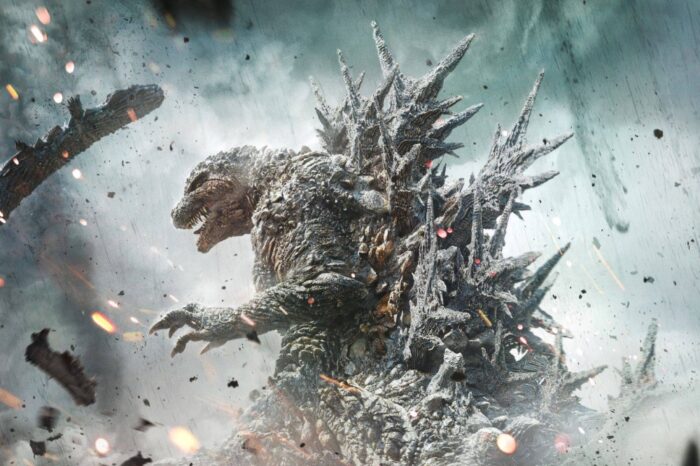Published by Japan Forward 30/11/2023
The year is 1947 and Godzilla is on the rampage in Tokyo, chewing up train carriages like candy bars. Japan is controlled by the American Occupation forces, but General MacArthur refuses to intervene for fear of inciting a military showdown with the Soviet Union.
The Self Defence Forces have yet to be created so the country is institutionally helpless. If Japan was at zero point in 1945 and 1946, now things are worse. It’s at “zero minus one”.
“The war is not over,” says our hero, a chap called Koji Shikishima. We know he’s not a very heroic hero because of his behaviour two years before. A kamikaze pilot sent out to die a glorious death, he decided to ignore his instructions and fly onward to the island of Otoshima instead.
That was an unfortunate choice of refuge, as all Godzilla nerds will recognize. This particular (fictional) isle in the Ogasawara chain has been the monster’s home territory since the first movie in the series hit the screens seventy years ago.
Shikishima does much worse than aborting his suicidal mission. Frozen with fear, he cannot muster the willpower to use his machine gun on Godzilla who has emerged from the centre of the island intent on mayhem. Result: nearly all the Japanese servicemen stationed on the island are killed.
Back in Tokyo, he suffers from flashbacks and survivors’ guilt and is unable to respond to the super-attractive woman with whom he shares a rickety shack in Tokyo’s burnt-out ruins.
What he needs is a chance for redemption. Indeed, that is what everybody wants – and Godzilla gives it to them.
In the words of writer Ian Buruma, Godzilla is “a very political monster”. The very first film in the series – still the scariest, despite the primitive technology of the era – was made in 1954, shortly after the “Lucky Dragon” incident. The so-named Japanese fishing boat was caught in the fallout from an American H-bomb test on Bikini Atoll, sickening the crew, one of whom died, and stoking anti-war and anti-American sentiment.
In the early 1970s, when pollution scandals such as Minamata disease had become a national scandal, Godzilla turned saviour, battling a nastier monster called Hedorah, after the Japanese word for sludge. “Godzilla vs Hedorah” (1971, directed by Yoshimitsu Banno) also offers an interesting glimpse into the psychedelic disco culture of the time.
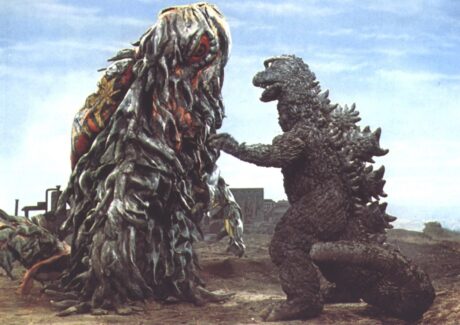
Big G takes on the king of slime
Godzilla films reflect the era in which they were made, its fears and hopes and desires. That is still the case in the twenty first century. Anyone watching “Shin Godzilla” (2016, directed by Hideaki Anno and Shinji Higuchi) could not help but be reminded of the devastating triple disaster of earthquake, tsunami and nuclear meltdown that hit Japan five years before.
Particularly salient was the scene in this movie in which the hapless prime minister denies that the strange turbulence in Tokyo Bay is caused by some kind of creature. At that very moment, Godzilla chooses to surface.
Substitute nuclear meltdown for monster and you have what happened to Prime Minister Naoto Kan of the Democratic Party of Japan when he denied that reactors in Fukushima were in a critical state just before the roof blew off one of them on live TV.
In the film, the Prime Minister and several senior government figures are killed when Godzilla smashes their helicopter. Far more troubling, the United Nations gives Japan an ultimatum. Dispose of the monster promptly or leave it to the members of the Security Council – who will use nuclear weapons to neutralize the threat.
In “Shin Godzilla”, Japan is a weak and friendless country, led by mediocre politicians whose first instinct is to cover up unpleasant realities. Maverick thinkers, like Goro Maki, the scientist who predicted the coming of Godzilla, are condemned to obscurity. Not that the Americans are much better: when he was working for the U.S. “Department of Energy”, they prevented him from releasing his findings.
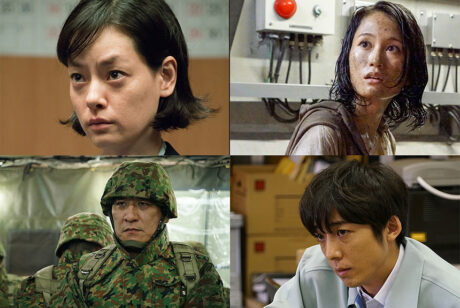
The people who take down Godzilla
Facing the prospect of their country being nuked for a third time in history, Japan’s young bureaucrats and scientists work like demons to come up with a solution. Fortunately, Maki’s notebooks have been found, though not the man himself, who appears to have committed suicide. Nonetheless, his legacy of counterintuitive ideas is enough to save the day.
In the end, Japan manages to regenerate itself, as it always does – in Godzilla movies and in real life. And so, of course, does Godzilla.
Interestingly, “Shin Godzilla” was praised by the late Shinzo Abe who was half-way through his stint as prime minister when it opened. He particularly appreciated the “cool” depiction of the Self-Defense Forces, who play a large role in defeating the monster.
Less impressed was Abe’s longstanding rival in the ruling Liberal Democratic Party, Shigeru Ishiba who, half-jokingly, claimed that the deployment of the Self-Defense Forces, as shown in the film, was unconstitutional.
If Godzilla represents our worst nightmares, it is no surprise that such issues should enter the conversation. After all, Japan has three nuclear-armed, somewhat hostile countries as near neighbours. China, Russia and North Korea could be considered three Godzillas, a large one, a medium-sized one and a small but vicious one.
Russia’s invasion of Ukraine came as a particular shock to Japan as it put paid to delusions about the U.N. and indicated that might is still right in the international arena. Notably, there has been almost no pushback against the government’s plan to double defence spending, and Japan’s armament manufacturers are already forecasting bumper profits.
This is the context in which the latest Godzilla movie has been made. Director Takashi Yamazaki has set it in the 1940s, but with one eye on the world of today.
The civilian volunteers who band together to subdue the monster are mostly war veterans, but none of high rank. They are led by a good-humoured and pragmatic former Naval captain who wears his peaked hat during the final battle. The eccentric boffin with a wacky hairstyle who devises the anti-Godzilla plan was also in the Navy, where he worked as developer of marine weapons.
A key element in his strategy is the prototype of an advanced fighter plane, the Shinden, which never flew, Japan having surrendered before it was ready for action. Unlike Otoshima Island, the Shinden actually existed, though no photos or traces of it remain.
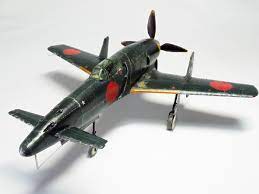
It might have looked like this…
Noticeably, there is no mention of the Imperial Japanese Army, and references to the lost war are dark and cynical. According to the volunteers, the fight against Godzilla is not a fight to the death, as the Pacific War was described in the propaganda, but a fight for the future.
Specific mention is made of the extraordinary waste of human life that the wartime military leaders were willing to tolerate and even encourage. It was typical, one man recalls, that they didn’t bother to have ejection mechanisms installed in planes.
In contrast, the slogan of of anti-Godzilla coalition is “resist and survive”. The leaders explain the risks frankly to potential members and tell them they are free to leave with no hard feelings. Several take that option. Later, others with no military experience ask to be allowed to join the noble cause.
In other words, they are not very different from today’s Self Defence Forces, as lauded by Abe. In a struggle against an awesome foe, what kind of weapons do you want? The most advanced available, such as the Shinden. What kind of leader do you want? A calm, authoritative figure like Captain Tanaka. Your personnel? Professionals with high morale.
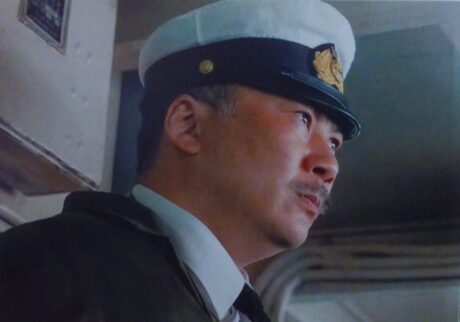
Tanaka: a born leader
Director Yamazaki makes a small but important change to the story of Godzilla’s creation. By showing the monster causing mayhem in the last months of the war, he breaks the link with nuclear weapons, which were yet to be tested anywhere near Japan or used. Yes, Yamazaki’s Godzilla may have powered up in 1947 when the Americans started nuclear tests on Bikini Atoll, but he cannot serve as metaphor for nukes.
Rather, he becomes a metaphor for all possible forms of human destructiveness. He was there all along, and he will always come back.
Japan finally seems ready to accept the implications of that reality.
